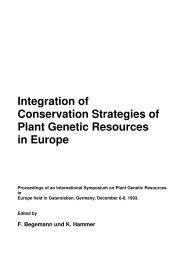Agrobiodiversität in Deutschland - Genres
Agrobiodiversität in Deutschland - Genres
Agrobiodiversität in Deutschland - Genres
Sie wollen auch ein ePaper? Erhöhen Sie die Reichweite Ihrer Titel.
YUMPU macht aus Druck-PDFs automatisch weboptimierte ePaper, die Google liebt.
14 | Johannes Engels<br />
From the earliest conservation and use activities<br />
of genetic resources until today<br />
Domestication and subsequent crop improvement took place and still take<br />
place <strong>in</strong> many locations worldwide, especially <strong>in</strong> the so-called centres of<br />
orig<strong>in</strong> of agriculture. These centres co<strong>in</strong>cide with centres of diversity and<br />
many of our important crop plants orig<strong>in</strong>ated and spread from them. The<br />
unrestricted exchange of crops and genetic diversity has played an important<br />
role <strong>in</strong> help<strong>in</strong>g agriculture to evolve and to spread to new areas and<br />
cont<strong>in</strong>ents. In a number of known cases, the domestication experiences<br />
with certa<strong>in</strong> crops were transferred to new situations <strong>in</strong> new geographical<br />
areas and by different people. Thus, the availability and movement of<br />
genetic resources have allowed new crops to be domesticated and/or to be<br />
grown <strong>in</strong> new regions, frequently without their natural enemies and thus,<br />
significantly contribut<strong>in</strong>g to a more effective agriculture. Such unrestricted<br />
movements of genetic resources have taken place worldwide.<br />
Dur<strong>in</strong>g the 18th and 19th centuries a keen <strong>in</strong>terest <strong>in</strong> the diversity of horticultural<br />
species developed, especially <strong>in</strong> rare and ‘strange’ species, and<br />
targeted expeditions were mounted to explore and collect such material.<br />
Alexander von Humboldt (14.09.1769 – 06.05.1859) was one of the explorers,<br />
and through his keen scientific <strong>in</strong>terest he discovered numerous new plant<br />
species dur<strong>in</strong>g his European and American expeditions. He described them<br />
(at least 12 species are named after him) and brought them home to Berl<strong>in</strong>.<br />
This was all done <strong>in</strong> the absence of any legal or moral constra<strong>in</strong>ts or even<br />
the notion that such scientific activities could be subversive!<br />
With the discovery of the Mendelian laws of <strong>in</strong>heritance (published <strong>in</strong><br />
1865 and rediscovered at the turn of the 19th century) professional plant<br />
breed<strong>in</strong>g evolved rapidly and the need for more genetic diversity <strong>in</strong>creased<br />
steadily with progressive breed<strong>in</strong>g efforts. Professional plant breeders thus<br />
established their so-called breeders’ collections that were ma<strong>in</strong>ta<strong>in</strong>ed over<br />
the short to medium-term to facilitate ongo<strong>in</strong>g and future breed<strong>in</strong>g efforts.<br />
These collections provided, <strong>in</strong> many <strong>in</strong>stances, the foundation of and<br />
evolved <strong>in</strong>to genebank collections, <strong>in</strong>creas<strong>in</strong>gly with long-term conservation<br />
objectives. The transfer of genes and traits from less closely related<br />
species became possible with the development of advanced technologies<br />
and thus an <strong>in</strong>creased <strong>in</strong>terest <strong>in</strong> a wider array of material developed. At the<br />
same time the modern technologies triggered <strong>in</strong>creas<strong>in</strong>g application of <strong>in</strong>-<br />
tellectual property protection, i.e. variety protection and patents, and thus<br />
impacted negatively on the unrestricted availability of genetic resources.<br />
Nikolai Vavilov (25.11.1887 - 26.01.1943) was an explorer and plant collector<br />
who had been given the huge task of spread<strong>in</strong>g agriculture eastwards <strong>in</strong> the<br />
Soviet Union, <strong>in</strong>to Siberia. Consequently, significant species and crop diversity<br />
was required and collected on all cont<strong>in</strong>ents and brought to Len<strong>in</strong>grad<br />
(today St. Petersburg) for conservation and evaluation. Thus, one of the first<br />
and biggest genebanks <strong>in</strong> the world was established. This approach allowed<br />
Vavilov to postulate the centres of orig<strong>in</strong> of agriculture and to discover that<br />
genetic diversity was concentrated <strong>in</strong> eight (and a half) centers of diversity.<br />
Vavilov’s activities were only possible as there were no restrictions placed on<br />
collect<strong>in</strong>g and mov<strong>in</strong>g germplasm around the globe.<br />
With the explicit recognition of national sovereign rights of states over their<br />
biodiversity, but also with the obligation to make these resources available<br />
under mutually agreed terms, <strong>in</strong>clud<strong>in</strong>g allow<strong>in</strong>g collect<strong>in</strong>g of genetic resources<br />
with prior <strong>in</strong>formed consent, the Convention on Biological Diversity<br />
(entered <strong>in</strong>to force <strong>in</strong> December 1993) heralded a new era with respect to the<br />
legal status of biodiversity. It <strong>in</strong>troduced the concept of ‘access and benefit<br />
shar<strong>in</strong>g’ and this was further elaborated <strong>in</strong> the International Treaty (entered<br />
<strong>in</strong>to force <strong>in</strong> June 2004). The latter established the ‘multilateral system for<br />
facilitated access to plant genetic resources’ for approximately 35 crops and<br />
some 30 grass species under governmental control and management.<br />
In conclusion, aga<strong>in</strong>st current legal standards and regulations, both von<br />
Humboldt and Vavilov were biopirates. However, we can be pleased that<br />
they did carry out the research they were <strong>in</strong>terested <strong>in</strong> as that, directly or<br />
<strong>in</strong>directly, contributed to the development of the genebank concept and<br />
that it resulted <strong>in</strong> the establishment of one of the first genebanks, almost<br />
hundred years ago! Whereas we can make the statement that genebanks can<br />
be regarded as a safe haven for genetic resources, we also have to make sure<br />
that their important role is not underm<strong>in</strong>ed by restrictive and/or complicated<br />
legal regulations.<br />
Johannes Engels | 15










